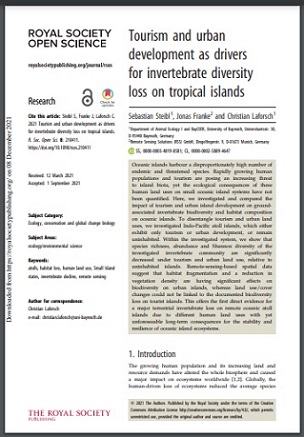
Oceanic islands harbour a disproportionately high number of endemic and threatened species. Rapidly growing human populations and tourism are posing an increasing threat to island biota, yet the ecological consequences of these human land uses on small oceanic island systems have not been quantified. Here, we investigated and compared the impact of tourism and urban island development on ground-associated invertebrate biodiversity and habitat composition on oceanic islands. To disentangle tourism and urban land uses, we investigated Indo-Pacific atoll islands, which either exhibit only tourism or urban development, or remain uninhabited. Within the investigated system, we show that species richness, abundance and Shannon diversity of the investigated invertebrate community are significantly decreased under tourism and urban land use, relative to uninhabited islands. Remote-sensing-based spatial data suggest that habitat fragmentation and a reduction in vegetation density are having significant effects on biodiversity on urban islands, whereas land use/cover changes could not be linked to the documented biodiversity loss on tourist islands. This offers the first direct evidence for a major terrestrial invertebrate loss on remote oceanic atoll islands due to different human land uses with yet unforeseeable long-term consequences for the stability and resilience of oceanic island ecosystems.














